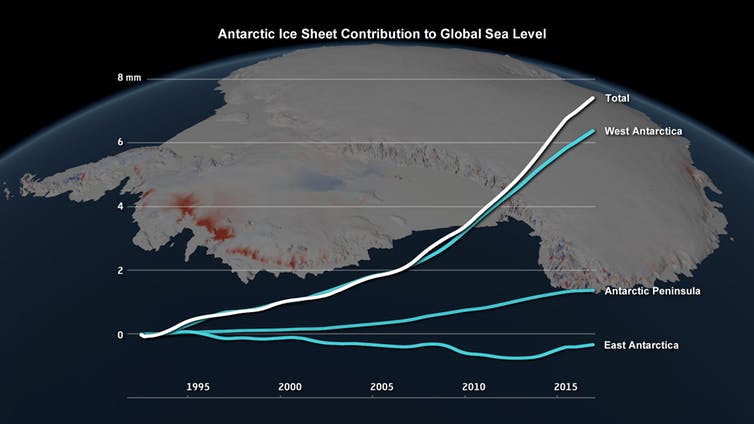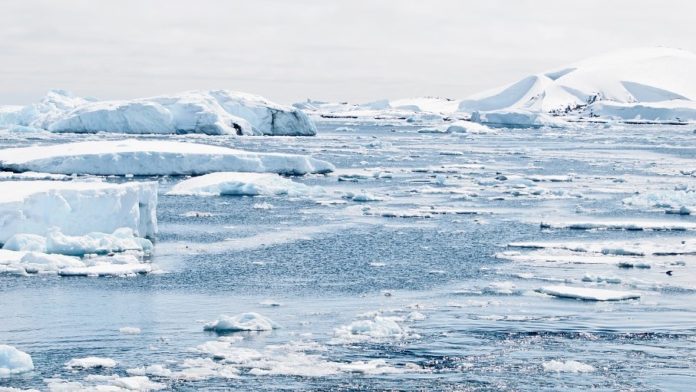From space, the Antarctic looks like an impenetrable ice fortress. It’s massive enough to bury mountains, and its total land mass is comparable to that of the USA and Mexico combined.
If it melted in its entirety, global sea levels would rise by a whopping 58 metres, but even a fractional melt could displace hundreds of millions of coastal residents the world over, and now we have some of the best evidence yet to justify those fears.
A landmark study published in Nature demonstrates that nearly three trillion metric tonnes of ice were lost between 1992 and 2017, raising global sea levels by approximately 8mm.
The results were gathered from the most thorough satellite survey of changes in the Antarctic’s ice sheets to date, with the collaboration of 84 scientists from 44 international organizations including Canadian institutions.
“We have long suspected that changes in Earth’s climate will affect the polar ice sheets,” says lead researcher, Andrew Shepherd. “Thanks to the satellites our space agencies have launched, we can now track their ice losses and global sea level contribution with confidence.”
Disaster looms closer as the melt accelerates
Of greatest concern is the accelerating rate of decline. Antarctica was losing approximately 76 billion tonnes of ice per year prior to 2012 and was considered a minor factor in rising sea levels.
But the results of this study show that between 2012 and 2017, the rate of Antarctic ice loss skyrocketed up to 219 billion tonnes per year.
This translates to a 0.6 mm annual contribution to rising sea levels (a three-fold increase over the pre-2012 rate), making Antarctica a significant force in the 3 mm increase in global sea levels every year (the other dominant player being thermal expansion caused by the warming of the ocean).
“According to our analysis, there has been a steep increase in ice losses from Antarctica during the past decade, and the continent is causing sea levels to rise faster today than at any time in the past 25 years,” says Shepherd. “This has to be a concern for the governments we trust to protect our coastal cities and communities.”
The researchers note that the majority of losses are coming from the West Antarctic Ice Sheet, which is inherently unstable. The concaved nature of its formation allows warm water to get underneath and unhinge huge glaciers before they crash into the ocean.
Conversely, the East Antarctica Ice Sheet’s losses are considered negligible. Most of its ice rests on bedrock above sea level, saving it from the structural vulnerability of its western counterpart.

Long-term outlook is ever more precarious
A couple of millimetres might not sound like a lot, but an unimpeded, accelerating trend could wreak havoc on coastal-living humans by the next century.
“We’ve all been caught by surprise by the pace of which Antarctic ice loss has increased,” says Shepherd. “0.6 mm sea level rise doesn’t sound like a large number to the public, but it means a lot to the potential of future sea level rise.”
The Intergovernmental Panel on Climate Change (IPCC) published its fifth assessment in 2014, with tiered projections for the contribution of Antarctica and other factors over the next century.
Previous studies placed Antarctica’s contribution in the IPCC’s lower projection, but the data from 2012 – 2017 in the current study has shifted it to the higher projection. According to co-author Tom Slater, we can expect Antarctica alone to contribute a 15cm rise in global sea levels by 2100 at this rate.
“Limiting global warming to 2℃ by 2100, as set by the Paris Agreement, looks increasingly unlikely,” says Slater. “The rate at which ice losses from Antarctica will increase in response to a warming world remains uncertain. It is important, now more than ever, that we continue to use satellites to monitor Antarctica in order to better prepare ourselves for the challenges ahead.”









































